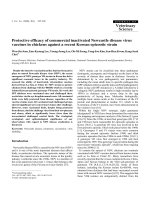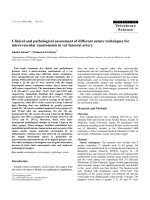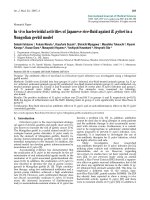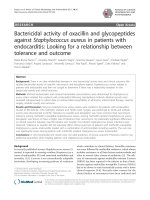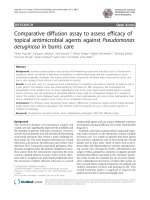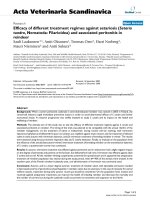Efficacy of different entomopathogenic fungi against mango hoppers in middle Gujarat
Bạn đang xem bản rút gọn của tài liệu. Xem và tải ngay bản đầy đủ của tài liệu tại đây (335.12 KB, 7 trang )
Int.J.Curr.Microbiol.App.Sci (2020) 9(8): 2310-2316
International Journal of Current Microbiology and Applied Sciences
ISSN: 2319-7706 Volume 9 Number 8 (2020)
Journal homepage:
Original Research Article
/>
Efficacy of Different Entomopathogenic Fungi against
Mango Hoppers in Middle Gujarat
B. L. Raghunandan, T. B. Kapadiya, N. B. Patel*, N. M. Patel and D. M. Mehta
AICRP on Biological Control of Crop Pests, Anand Agricultural University,
Anand (Gujarat), India
*Corresponding author
ABSTRACT
Keywords
Mango hopper,
Efficacy,
Entomopathogenic
fungi
Article Info
Accepted:
20 July 2020
Available Online:
10 August 2020
Mango hopper is one of the most destructive pests of mango globally which
causes considerable monetary loss. An attempt was made to evaluate different
entomopathogenic fungi against mango hoppers at Horticulture farm, Anand
Agricultural University, Anand (Gujarat) during the year 2011-2012, 2012-13
and 2013-14. Among seven treatments imposed for the management of mango
hoppers, the treatment with Verticillium lecanii (Lecanicillium lecanii) 1.15%
WP (2x108cfu/g) on tree trunk during off-season + at flowering period
recorded lower number of mango hoppers, which was found at par with
Metarhizium anisopliae 1.15% WP (2x108cfu/g)on tree trunk during offseason + at flowering period.
Introduction
Mango (Mangifera indica Linn.) is native of
Indo-Burma region andmost ancient among
the tropical fruits. Mangois considered as the
“King of fruits” due to its attractive fragrance,
delicious taste, excellent flavour, nutritional
richness (Vitamin A and C) and health
promoting qualities. Among the pests that
infesting mango, the cicadellids (jassids)
popularly known as „Mango hoppers‟ are
economically important (Gangolly et al.,
1957). Mango hopper, Amritodus atkinsoni
(Lethierry) mainly inhabits the trunk region
and new vegetative flush, while two
Idioscopus species, viz., Idioscopus clypealis
(Lethierry) and Idioscopus nitidulus (Walker)
infest during flowering season, which cause
yield loss up to 50-60% in case of severe
infestation (Tandonand Verghese,1985 and
Gundappa, et al., 2014). Both the nymphs and
adults of the hopper mainly suck the sap from
tender shoots, leaves and inflorescence, which
causes panicles shrivel, turn brown and finally
fall off (Das, et al., 1969). Hoppers also
excrete honey dew which causes sooty mould
on leaf surface, interferes with the
photosynthetic activity of the plant and finally
affect the quality of fruit production.
2310
Int.J.Curr.Microbiol.App.Sci (2020) 9(8): 2310-2316
As regard control, using of numbers of broadspectrum insecticides is harmful to natural
enemies on the crop. In addition to this, it
creates environmental pollution and leaves
pesticides residue on fruits. Pesticidal
residues on mangoes affect export there by
leading to financial losses. To overcome these
problems, there is a need to develop the
management techniques which are ecofriendly and safer to natural enemies. An
important mechanism for mango hopper
control should be the use of fungal
entomopathogens. Therefore, the present
study on evaluation of biological control
agents against mango hoppers was carried
out.
Materials and Methods
A study one valuation of entomopathogenic
fungi against mango hoppers was carried out
at Horticulture farm, AAU, Anand during
2011-12, 2012-13 and 2013-14. The
experiment was laid out with cultivar, Langra
in Completely Randomized Design (CRD)
was followed with three repetitions. The
experiment consists of 7 treatments (Table 1)
and each tree was considered as one
repetition. One off-season spray was given on
tree trunk during the month of November and
three sprays were given on foliage during
flowering stage at fortnightly interval with the
initiation of pest. Observations on number of
mango hoppers were recorded before
imposing the treatment as well as 7 and 14
days after treatment. Ten twigs-panicles
(approx. 15 cm length) from each tree were
observed and number of hoppers per twig was
recorded.
The data obtained from the experiments were
subjected to square root transformation and
subjected to ANOVA analysis. Significant
differences among the means of different
treatments were tested using Duncan‟s new
multiple range test (DNMRT)
Results and Discussion
The year wise data on bio-efficacy of
different biocontrol agents against hoppers
infesting mango are presented hereunder:
Year 2011-12
The data (Table 2) on population of mango
hopper recorded before spray showed nonsignificant difference among different
treatments indicated that the hoppers
population was uniformly distributed in all
the experimental trees.
The data of pooled over periods and sprays
for the first year (rabi, 2011-12) revealed
significant reduction in hoppers population in
all the treated trees compared to untreated
control. The reduction in hoppers population
was significantly higher in treatment of
imidacloprid 17.8 SL applied on tree trunk
during off-season + one spray of the same
applied at flowering stage (4.56 hoppers/
twig) than rest of the treatments. However, in
case of bio-pesticidal treatments, trees
sprayed with either V. lecanii (5.90 hoppers/
twig) or M. anisopliae (6.16 hoppers/ twig) on
tree trunk during off-season + at flowering
stage also proved effective treatment and
stood next to the chemical treatment.
Whereas, application of entomopathogenic
fungi only on the tree trunk during off-season
proved inferior against mango hoppers.
Year 2012-13
Data on hoppers population recorded prior
and 7 and 14 days after each spray in different
treatments during rabi, 2012-13 are presented
in Table 3. Data indicated that the hoppers
population was uniformly distributed in all
the experimental trees as it evident from the
observations recorded before imposing of
spray.
2311
Int.J.Curr.Microbiol.App.Sci (2020) 9(8): 2310-2316
Table.1 Details of entomopathogenic fungi used against mango hoppers
Treatments
T1
T2
T3
T4
T5
T6
T7
Concentration
Application of Metarhiziumanisopliae1.15% WP on tree
trunk during off-season + at flowering period
Application of M. anisopliae1.15% WP on tree trunk during
off-season
Application of Verticilliumlecanii1.15%
WP(Lecanicilliumlecanii) on tree trunk during off-season +
at flowering period
Application of V.lecanii1.15% WP(L. Lecanii) on tree trunk
during off-season
One spray of imidacloprid 17.8SL (26.7 ga.i/ha) on tree
trunk during off–season
One spray of imidacloprid 17.8SL (26.7 ga.i/ha) on tree
trunk during off–season + at flowering period
Untreated control
2x108cfu/g
Quantity (ml or g)/
10 litre water
40
2x108cfu/g
40
2x108cfu/g
40
2x108cfu/g
40
0.005%
3
0.005%
3
-
-
Table.2 Effectiveness of different entomopathogenic fungi against mango hoppers (2011-12)
Treatments
No. of mango hoppers/twig
1st Spray
2nd Spray
3rd Spray
Pooled over
periods over
7
14
7 DAS
14
7
14
sprays
DAS
DAS
DAS
DAS
DAS
3.44*
2.85
3.07
2.38
2.70
2.18
2.30
2.58
T1
(11.33) (7.62)
(8.92)
(5.16)
(6.79)
(4.25)
(4.80)
(6.16)
3.31
3.58
3.75
3.84
3.80
3.80
3.91
3.79
T2
(10.46) (12.32) (13.56) (14.25) (13.94) (13.94) (14.79)
(13.86)
3.42
2.91
2.95
2.53
2.56
2.55
2.15
2.53
T3
(11.20) (7.97)
(8.20)
(5.90)
(6.05)
(6.00)
(4.12)
(5.90)
3.51
3.53
3.61
3.58
3.71
3.71
3.83
3.67
T4
(11.82) (11.96) (12.53) (12.32) (13.26) (13.26) (14.17)
(12.97)
3.17
3.39
3.69
3.72
3.63
3.63
3.75
3.64
T5
(9.55) (10.99) (13.12) (13.34) (12.68) (12.68) (13.56)
(12.75)
3.24
2.61
2.85
2.10
2.33
2.33
1.87
2.25
T6
(10.00) (6.31)
(7.62)
(3.91)
(4.93)
(4.93)
(3.00)
(4.56)
3.65
3.81
3.91
3.82
3.94
3.94
4.08
3.93
T7
(12.82) (14.02) (14.79) (14.09) (15.02) (15.02) (16.15)
(14.94)
0.28
0.22
0.24
0.21
0.22
0.17
0.22
0.10
S. Em± T
0.21
YxT
NS
0.66
0.71
0.63
0.66
0.52
0.66
0.27
C.D. at 5% T
NS
YxT
11.71
11.95
11.47
11.55
9.79
12.11
11.49
C. V. (%) 14.21
* Figures in parentheses are retransformed values; those outside
transformed values
X 0.are
5
NS = Non –significant
DAS = Days After Spray
Before
spray
2312
Int.J.Curr.Microbiol.App.Sci (2020) 9(8): 2310-2316
Table.3 Effectiveness of different entomopathogenic fungi against mango hoppers (2012-13)
Treatments
No. of mango hoppers/twig
Before
1 Spray
2nd Spray
3rd Spray
Pooled over
spray
period over
7 DAS
14
7 DAS
14
7 DAS 14 DAS
sprays
DAS
DAS
3.70*
3.12
3.43
2.78
2.98
2.66
2.69
2.94
T1
(13.19)
(9.23) (11.26) (7.23)
(8.38)
(6.58)
(6.74)
(8.14)
3.66
3.82
3.98
4.15
4.07
4.16
4.18
4.06
T2
(12.90) (14.09) (15.34) (16.72) (16.06) (16.81) (16.97)
(15.98)
3.70
3.24
3.33
2.90
2.88
2.67
2.62
2.94
T3
(13.19) (10.00) (10.59) (7.91)
(7.79)
(6.63)
(6.36)
(8.14)
3.79
3.84
3.87
3.90
3.98
4.05
4.16
3.97
T4
(13.86) (14.25) (14.48) (14.71) (15.34) (15.90) (16.81)
(15.26)
3.56
3.71
3.93
4.06
3.92
3.97
4.09
3.95
T5
(12.17) (13.26) (14.94) (15.98) (14.87) (15.26) (16.23)
(15.10)
3.58
2.95
3.08
2.44
2.69
2.19
2.36
2.62
T6
(12.32)
(8.20)
(8.99)
(5.45)
(6.74)
(4.30)
(5.07)
(6.36)
3.93
4.37
4.27
4.14
4.24
4.25
4.39
4.28
T7
(14.94) (18.60) (17.73) (16.64) (17.48) (17.56) (18.77)
(17.82)
0.22
0.18
0.19
0.19
0.18
0.13
0.17
0.08
S. Em ± T
0.18
YxT
NS
0.56
0.59
0.60
0.56
0.42
0.53
0.23
C.D. at 5% T
NS
YxT
10.64
8.91
9.14
9.90
9.06
7.00
8.76
8.86
C. V. (%)
* Figures in parentheses are retransformed values; those outside
transformed values
X 0.are
5
NS = Non –significant
DAS = Days After Spray
st
Table.4 Effectiveness of different entomopathogenic fungi against mango hoppers (2013-14)
Treatments
T1
T2
T3
T4
T5
T6
T7
Before
spray
3.71
(13.26)
3.84
(14.25)
3.72
(13.34)
3.92
(14.87)
3.80
(13.94)
3.70
(13.19)
3.95
(15.10)
1st Spray
7 DAS 14 DAS
3.32
2.79
(10.52)
(7.28)
3.77
3.86
(13.71) (14.40)
3.33
2.80
(10.59)
(7.34)
3.80
3.82
(13.94) (14.09)
3.68
3.82
(13.04) (14.09)
2.32
2.02
(4.88)
(3.58)
4.36
4.35
(18.51) (18.42)
No. of mango hoppers/twig
2nd Spray
3rd Spray
7 DAS 14 DAS 7 DAS
14 DAS
3.08
3.08
2.73
2.87
(8.99)
(8.99)
(6.95)
(7.74)
3.77
3.84
3.93
3.94
(13.71) (14.25) (14.94)
(15.02)
3.08
3.07
2.75
2.85
(8.99)
(8.92)
(7.06)
(7.62)
3.72
3.72
3.94
3.83
(13.34) (13.34) (15.02)
(14.17)
3.69
3.86
3.96
3.95
(13.12) (14.40) (15.18)
(15.10)
2.13
2.18
2.08
2.05
(4.04)
(4.25)
(3.83)
(3.70)
4.13
4.26
4.22
4.38
(16.56) (17.65) (17.31)
(18.68)
2313
Pooled over period
over sprays
2.98
(8.38)
3.85
(14.32)
2.98
(8.38)
3.81
(14.02)
3.83
(14.17)
2.13
(4.04)
4.29
(17.90)
Int.J.Curr.Microbiol.App.Sci (2020) 9(8): 2310-2316
0.27
0.25
0.25
0.22
0.23
0.20
S. Em ± T
YxT
NS
0.77
0.76
0.65
0.71
0.63
C.D. at 5% T
YxT
12.50
12.46
12.90
11.09
11.88
10.75
C. V. (%)
* Figures in parentheses are retransformed values; those outside
X 0.are
5
NS = Non –significant
DAS = Days After Spray
0.26
0.10
0.18
0.80
0.29
NS
13.40
12.61
transformed values
Table.5 Effectiveness of different entomopathogenic fungi against mango hoppers (Pooled over
years)
Treatments
No. of mango hoppers/ twig
2011-12
2012-13
2013-14
Pooled
2.58b
2.94b
2.98b
2.83b
T1
(6.18)
(8.14)
(8.38)
(7.51)
c
cd
c
3.79
4.06
3.85
3.90c
T2
(13.86)
(15.98)
(14.32)
(14.71)
2.53ab
2.94b
2.98b
2.82b
T3
(5.90)
(8.14)
(8.38)
(7.45)
3.67c
3.97c
3.81c
3.82c
T4
(12.97)
(15.26)
(14.02)
(14.09)
c
c
c
3.64
3.95
3.83
3.81c
T5
(12.75)
(15.10)
(14.17)
(14.02)
2.25a
2.62a
2.13a
2.33a
T6
(4.56)
(6.36)
(4.04)
(4.93)
3.93c
4.28d
4.29d
4.16d
T7
(14.94)
(17.82)
(17.90)
(16.81)
S.
C. D.
S.
C. D. at 5%
S.
C. D. at S. Em.+
C. D. at
Em.+
at 5%
Em.+
Em.+ 5%
5%
0.10
0.27
0.08
0.23
0.09
0.26
0.05
0.14
Treatments (T)
0.03
0.09
Years (Y)
0.03
0.10
0.03
0.08
0.05
NS
0.03
0.09
Sprays (S)
0.03
0.08
0.02
0.07
0.04
NS
0.03
NS
Periods (P)
0.09
NS
TxY
0.05
0.14
0.04
0.11
0.06
NS
0.09
0.24
TxS
0.09
NS
0.08
NS
0.12
NS
0.07
NS
TxP
0.06
NS
YxS
0.05
NS
YxP
0.07
NS
0.06
NS
0.10
NS
0.05
NS
SxP
0.15
NS
TxYxS
0.12
NS
TxYxP
0.08
NS
YxSxP
0.13
NS
0.11
NS
0.17
NS
0.12
NS
TxSxP
0.21
NS
TxYxSxP
11.49
8.86
12.13
10.86
C.V.%
Figures in parentheses are retransformed values; those outside
transformed values
X are
0.5
Figures in Letter(s) in common are statistically at par as per DNMRT
NS = Non –significant
2314
Int.J.Curr.Microbiol.App.Sci (2020) 9(8): 2310-2316
Pooled over periods and sprays data for rabi,
2012-13 indicated that the treatment of
imidacloprid 17.8 SL registered significantly
least (6.36 hoppers/ twig) number of hoppers
compared to rest of the treatments. While
among the bio-pesticides treatments, mango
trees sprayed either with V. lecanii or M.
anisopliaeon tree trunk during off-season + at
flowering stage registered lowest (8.14
hoppers/ twig) numbers of hoppers than rest
of the treatments. The treatment of alone
application of V. lecaniior M. anisopliae only
during off-season on tree trunk proved
inferior in reducing hoppers population but
registered lower hoppers than untreated
control (17.82 hoppers/ twig).
over years depicted that significantly lowest
number of mango hopper/twig was recorded
in the treatment T3 i.e. application of V.
lecanni (Lecanicillium lecanii) on tree trunk
during off-season + at flowering period @ 5
g/ litre(7.45 hoppers/twig), which was found
at par with the treatment of T1i.e.application
of M.anisopliae on tree trunk during offseason
+
at
flowering
period(7.51
hoppers/twig). While, application of V.
lecanni (L.Lecanii) only on tree trunk during
off-season@ 5 g/ litre registered lower (14.09
hoppers/twig) numbers of hoppers and it was
followed by treatment of T2 i.e. application of
M.anisopliae on tree trunk during only during
off-season@ 5 g/ litre(14.71 hoppers/twig).
Year 2013-14
The efficacy entomopathogenic fungi against
mango hoppers also get support from Valvi et
al., (2018), who reported that mixed
application of Leccaniicillium leccanii +
Metarhizium anisopliae and sole application
of Metarhizium anisopliae found effective
against mango hopper. The entomopathogenic
fungi V. leccanii effectiveness in warding off
the mango hopper attack stated by Trivedi and
Singh (2007) and Singh (2008). The above
reports render support to the present
observation of superior efficacy of fungal
formulation against mango hoppers.
Pooled over periods and sprays data
computed for rabi, 2013-14 (Table 4)
indicated that all the treatments proved
significantly effective when compared with
control after 7 and 14 days of spray as well as
in pooled. The results indicated that the
lowest (4.04 hoppers/ twig) numbers of
hoppers were registered in the treatment of
imidacloprid 17.8 SL applied on tree trunk
during off-season + one spray of the same
applied at flowering stage. Both the
treatments of entomopathogenic fungi i.e. V.
lecanii and M. anisopliae registered equal
numbers of hoppers i.e. 8.38 hoppers/ twig
when applied on tree trunk during off-season
+ during flowering stage and found effective
next to chemical insecticide treatment. While,
the treatment of application of V. lecaniior M.
anisopliae only on the tree trunk during offseason proved inferior against mango hoppers
Pooled over periods and years
Among the different entomopathogenic fungi
evaluated for their bio efficacy against mango
hopper during 2011-12, 2012-13 and 2013-14
(Table 5), the data of pooled over periods
References
Das, G., Chavan, P. D., Sawant, B. N. 1969.
The mango hoppers mainly suck the sap
from tender shoots, leaves and
inflorescence, Indian Journal of Plant
Protection, 33:46-49.
Gangolly, S. R., Singh, R., Katyal, S. L.,
Singh, D. Mango, ICAR, New Delhi,
1957. 492.
Gundappa, Kamala Jayanthi P. D. and
Verghese,
A.
2014.
Migratory
behaviour of mango hopper, Idioscopus
spp. in relation to host plant flowering
phenology: A synchronous shift. An Int
2315
Int.J.Curr.Microbiol.App.Sci (2020) 9(8): 2310-2316
J Life Sci., The Bioscan,9(2): 639-641.
Singh, R. 2008. Evaluation of some
biopesticides against Mango hoppers
(Idioscopus clypealis and Amritodus
atkinsoni) and flower visitors of mango.
Indian journal of Plant Protection,
36(1):24-27.
Tandon, P. L. andVerghese, A. 1985. World
list of insect, mite and other pests of
mango. Technical Document No. 5,
IIHR, Bangalore.
Trivedi, T. P. and Singh, A. 2007. Validation
and Promotion of IPM in public Private
Partnership. Crop Care., 32:7-17.
Valvi, A. S., Mohite, P. B. and Tarate, S. P.
2018.
Efficacy
of
various
entomopathogenic
fungi
against
mangohopper (Amritodus atkinsoni
Leth.). Journal of Pharmacognosy and
Phytochemistry, 7(5): 1847-1851.
How to cite this article:
Raghunandan, B. L., T. B. Kapadiya, N. B. Patel, N. M. Patel and Mehta, D. M. 2020. Efficacy
of Different Entomopathogenic Fungi against Mango Hoppers in Middle Gujarat.
Int.J.Curr.Microbiol.App.Sci. 9(08): 2310-2316. doi: />
2316


